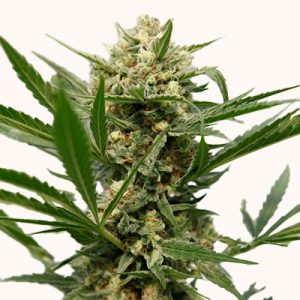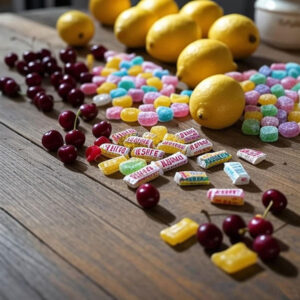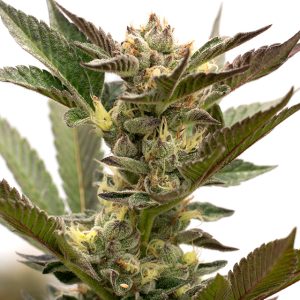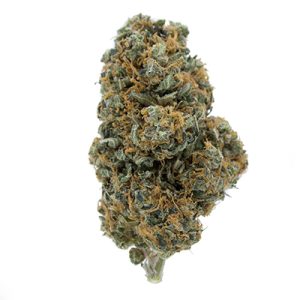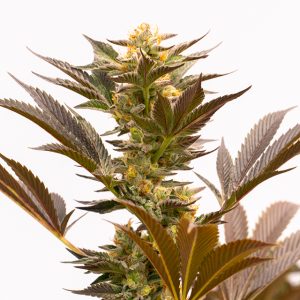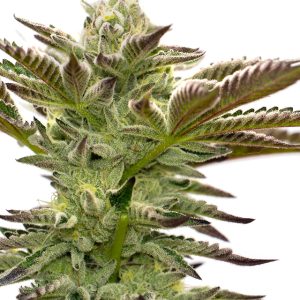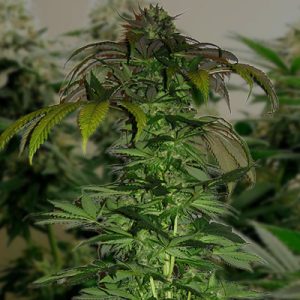Fruit Strains: Cannabis with Fruit Lineage
What Are Fruit Seeds?
Fruit family strains are a chosen family of fruity and colorful weeds that lift depression and soothe aching joints and muscles. They have also been touted as wonderful strains for people who suffer from disordered eating and anxiety. Their wide range of genetic origins make them very diverse when it comes to their effects and THC contents. Some of them are ideal for people who like low psychoactivity or high doses of CBD. Other strains are starlets in the recreational and 710 world due to their high resin production, gorgeous terpene profiles, and famous parent strains. While the weed world is full of fruity flavors, these strains differ from similar families based on specific fruits by being more of a melange. Especially present in this family are notes of red berries, mangos, melons, and deep purple fruits. Some of our most prominent Fruit family strains included descendants of luminaries like Grapefruit, Cherry Pie, Tangie, and Blueberry. All of these strains have their own places within other families, but their crosses have been added to this new clade in order to pay respect to their complexity. Kind Seed Co currently carries Fruit seeds in Grapefruit, Blue Fruit, and Fruit, all in automatic feminized varieties. We also have photoperiod seeds including Forbidden Fruit, Rock Fruit Fast, and Sugar Fruit. There are regular, unsexed photoperiod seeds in our collection in the strains Grapefruit and Gorilla Grapefruit. We also have two CBD fruit strains, Tutti Frutti and CBD Fruit, both in a photoperiod feminized style. When you want the highest quality genetics, come to KSCO!
Where Do Fruit Cannabis Seeds Come From?
The genes of Fruit plants come from all over the wide world of weed. While many other families can be traced back to just one or two ancestors, or a couple core elder ancestors like Skunk or Haze, the Fruit family is united by common phenotypes instead of common genotypes. Some of the luminaries in this family are descended from the heads of other households. Forbidden Fruit, for example, is what happens when Tangie and Cherry Pie get together. Cherry Pie is related to Grandaddy Purple and F1 Durb, and Tangie is a mix of California Orange and Skunk 1. Some of the others are more esoteric and boutique strains created by some of the most famous seed houses in Europe. Fruit Automatic was originally designed by Dinafem in the UK. It’s a combination of Roadrunner, Dinafem’s ruderalis, and Sweet Pink Grapefruit. Road Runner is related to Lowryder, Northern Lights 2, Williams Wonder, and a Mexican sativa. Rock Fruit was originally created by Blimburn Seeds, and is a combination of Magic Lemon, Mango Sherbert, and Honeydew Melon. Yet others are variations of already-famous strains that have enormous medical potential. CBD Fruit is the CBD version of the outstanding strain Grapefruit, which is a cross between C99 and some mystery Sativa. Blue Fruit is Mexican Purps combined with the illustrious Blueberry. These strains combined make some of the most vivid purples you’ve seen on a crop. This modern blended family is available in various styles from KSCO, who can deliver your fruit basket quickly and discreetly whenever you finalize your order.
Why Buy Fruit Seeds?
Fruit family seeds are a delicious and potent gang of healing plants that provide release from both mental and physical ailments. They are diverse enough to provide either potent THC or no THC, and can be grown to show a rainbow of deep dark colors. Above all, these strains are some of the most sweet and delicious crops if you are a fan of weed that tastes like fruit salad. It’s easier than ever to order the seeds of your dreams thanks to Kind Seed Co. You can access our catalog from anywhere in the country, at any time of day or night, from the comfort of your own home. Harder than filling out our easy to use payment field is deciding which of our more than six hundred and fifty strains to choose from! If you need some advice, our customer service phone line and email are open to help you make the choices that make sense for you. We take an ever-expanding list of payment types including cryptocurrency, debit, credit, Zelle, and Venmo. Once you’ve made the hard decision of which of our top of the line seeds are right for you and you’ve gone through our simple checkout process, it’s just five to fourteen business days to wait until your seeds arrive. In that time, you can read up on our website about how to grow your seeds and what training techniques and fertilizers to use. When you buy from Kind Seed Co, we take care of you from the time you order until you harvest your first crop.
Seed Storage Of Fruit Cannabis Seeds
With proper care, Fruit seeds can be sprouted up to six months after they’re ordered. But seeds are delicate and fragile and need to be kept in careful conditions to keep them in optimal shape while in storage. The three most important things to protect your seeds from are moisture, heat, and contamination. Keeping seeds in a space with a relative humidity between eight and ten percent will ensure that they’re neither appealing to pests, nor in danger of molding, and won’t germinate when it’s not time. Some people like to keep their seeds in a fridge, but inconsistent temperatures and humidity can make this an unstable place to keep seeds. If you trust your fridge, it can still be helpful to keep your seeds in the door or in the crisper if they’re in a waterproof and light proof container. Contamination is the only other factor that’s really crucial to protect your seeds from. Never touch your seeds with your bare hands unless you’re just about to plant them in soil. Oils and bacteria on hands can cause seeds to rot in storage, and have the potential to contaminate other seeds in their vicinity. These are all important if you’re keeping your seeds in storage for longer than a few weeks. If you’re hoping to germinate your purchases in just a couple of days, putting our high-quality seeds in a cool and dry drawer or cupboard isn’t going to hurt them. When you order your genetics from Kind Seed Co, we spare no expense to make sure you’re getting only the best!
Germinating Fruit Seeds
The trick to germinating Fruit seeds is to give them just enough moisture and a warm, dark place to sprout. This is most easily done using two ceramic plates, some paper towels, and some clean water below room temperature. If the spaces you have available to germinate in are not consistently warm or are drafty, you can also use a seedling heating pad and a freezer bag to keep the humidity and warmth locked in. Put your seeds into a clear glass and pour enough water overtop of them to cover them entirely. Leave them overnight in the glass, no longer than twelve hours. Use some of the water to wet a layer of paper towels on the ceramic plate, draining off any excess moisture until the paper towel is damp but not soaked. The paper towels should not drip when they’re lifted up. Arrange the seeds on the paper towel so they each have some space of their own, and top the seeds with another wet paper towel. Cover the seeds with another upside-down ceramic plate to create a microclimate that the seeds can germinate in. Watch your seeds, they should sprout in one to three days. After a week or so the sprouts should be long and strong enough to move to a seedling setup. Sprouts don’t have the roots yet to take water from the soil, so they get it from the air. Relative humidity should be above sixty percent until there are at least two sets of true leaves on your plants. With KSCO, you’re always in good hands!
Growing Fruit Cannabis Plants
Fruit family strains come from a wide variety of lineages, and they will each have their own particular way that they like to be treated. Some of these strains thrive indoors, others outdoors, and yet more are quite eager to grow wherever they’re planted. Many of these plants enjoy Mediterranean environments with dry summers and plenty of warm sun. Depending on their ancestors, some plants also do well in more temperate and continental spaces where the nights get a little chillier. This can bring out the deep purple and blue colors of some strains, especially those mixed with Blueberry or any of the Purple line. Many of these strains, Fruit Automatic included, will want some extra calcium and magnesium just as they start to flower. Along with some extra phosphorus, this will help their bud colas get not only tall but thick. Auto Fruit’s buds will grow in little clusters all over the plant and smell like a fruit salad covered in gasoline. Marijuana plants like Forbidden Fruit, with a mix of strong sativa and indica genes, will have various phenotypes that make them very flexible in terms of where and how they grow. However, it’s always wise to make sure that humidity is kept low for these plants so they can develop the delicious resin that gives them their family name. To find out the exact details regarding how best to treat your fruity crops, check out the extensive information that KSCO provides about all of our products. You could have a veritable fruit basket of seeds in just five to fourteen days.
Growing Flowers From Fruit Seeds Indoors
Indoor growing is a preferred method for many growers, who appreciate the ability to more minutely control the environmental conditions for their sometimes fickle plants. The Fruit family often thrives indoors, especially some of the smaller plants that do well in hydroponic tables. Rock Fruit plants, for example, thrive in hydro setups with low stress treatments. LSTs are techniques that bend or train plants without mutilating them at all. The Screen of Green is a very popular LST with Rock Fruit, which is when plant foliage is kept low using a mesh screen, often with two or three inch gaps where bud sites are encouraged to grow above the plant canopy. The plant ends up growing horizontally along the mesh, with their buds popping through to soak up the light. Growers with not a lot of space but big dreams would be wise to consider Fruit Auto for their crop. It does well in a Sea of Green, which uses overcrowded tables of young plants that are flipped to flower very early, growing an interlocking lawn of inflorescences. Of course, Fruit Auto doesn’t need a flip to grow beautiful flowers since it’s an autoflowering plant. Forbidden Fruit and CBD Fruit also grows well in a Sea of Green. Many of these techniques do well when paired with a little bit of regular pruning of their understories to keep humidity low. Keep the relative humidity low for these strains, between fifty-five and forty-five percent. Fruit plants like temperatures in the high sixties to high seventies. Growing with KSCO, we give you all the hot tips!
Growing Cannabis Flower Outdoors From Fruit Seed
Kind Seed Co carries over six hundred strains of plants, most of them more than suitable for growing outdoors. Fruit plants like temperatures in the seventies during the day, with more resinous plants preferring low humidity of around fifty percent. Soil is considered the perfect growing medium, especially outdoors, with a pH of six point two considered the standard. Rock Fruit grows well in sunny locations outdoors and prefers dry weather. Fruity Auto will grow wonderfully in Mediterranean conditions outdoors as well. Auto Fruit is the perfect back porch plant for people who just want a little bit of only medium-intense weed. It’s an autoflowering plant, so you don’t need to worry about changing its photoperiod like other plants. Some Fruit strains, especially the sativa dominant ones, will shoot up quickly and want a lot of space. Others will stay low and bushy, preferring to grow laterally. Forbidden Fruit is one that can thrive in outdoor environments. These plants can get four or five feet tall and benefit from the support of a trellis. It might be wise to top this plant at first, or FIM it. Topping and FIMming are very similar processes where the top growth of a plant is cut when it’s young in order to encourage its other branches to get bushy. Topping is done by cutting up to the first node, with leaves gone. FIMming cuts just the leaf growth without taking the stems or the node itself. WS is always working towards providing our customers with the most comprehensive and current information when it comes to growing techniques.
Typical Aroma Of Fruit Cannabis Buds
This may come as a surprise, but Fruit family buds tend to smell rather, well, fruity. This family didn’t get created because of genetics, they’re in this family because of their flavor and aroma profiles. Most of them are high in the terpenes myrcene and limonene, which represent the tropical, musky and fresh, citrus sides of the fruit spectrum respectively. Some of them can smell deeply of antioxidant-rich dark berries thanks to inclusions of the strain Blueberry. Rock Fruit is high in the terpene limonene, making it fresh but fruity in a lemon and sweet orange way. Fruit Automatic is high in terpinolene, a-myrcene, and b-caryophyllene. It smells fruity, with notes of strawberry, melons, and even hints of artificial banana and pineapple. The smoke of Forbidden Fruit has a muskiness reminiscent of a Kush, but sweet like tropical fruit. This strain is high in the terpenes caryophyllene and a-pinene, as well as ocimene and nerolidol, two minor terpenes with complex herbal and floral fragrances. CBD Fruit smells like hot and sweet hibiscus tea poured in the dirt. It’s somewhat coffee-like at times, with hints of jasmine and orange blossom. Blue Fruit autoflower has a fragrance like a slice of vanilla cheesecake with a hot berry compote on top. Those Blueberry genes fill the room with summer fruit wafts. If you’re someone who loves the fruity side of cannabis genetics, we have dozens of other fruity strains available right here on our website. When you shop with WS, you’ve got more choices than a kid in a candy shop!
Harvesting Time When Growing Fruit Strains
The most important thing to watch for when waiting for your plants to be ready to harvest are the trichomes on your flowers. Trichomes are the clear little nodules that cover the surface of flowers. They’re often described on cured buds as sugar or frosting, because by that time they are full of THC and have turned an opaque white. Using a magnifying glass, you can watch this process happen on the plants. It’s wise to start the flushing period where plants are given nothing but water for the last two weeks of their development, just as the trichomes are starting to turn white. This way, by the time the flush is over, roughly eighty percent of the trichomes will have turned white. This means that your plants have produced their maximum amount of THC. If you’re hoping to get a chronic that’s less trippy and more focused on killing pain and relaxing anxiety, you can wait until more of the trichomes have turned gold. This means the THCA in them has degraded to CBN, or cannabinol, which is a less-psychoactive cannabinoid that battles chronic pain. A plant like CBD Fruit, with its less than one percent THC, might be more difficult to watch in this way. We recommend watching instead the color change of the pistil hairs of your plants. CBD Fruit takes between eight and ten weeks for its flowers to mature. Other strains in this family take between two and three months of flowering. For detailed growing and harvesting information, check out our product pages at Weed Seeds today!
What Yield Can You Get From Fruit Plants
The yield you can get from cannabis plants will depend only partially on genetics, and more so on the conditions it’s grown in, the length of time the plant is allowed to vegetate for, and the amount of water and nutrients they’re given in their lifetime. Yield estimates are a good gauge for what to expect, but it’s by no means a guarantee. Most plants require, at minimum, a healthy dose of nitrogen when they are young, ample sunlight and water, and a combination of phosphorus, potassium, calcium and magnesium and other micronutrients as they begin to flower. Rock Fruit grows up to four hundred grams of weed per square meter, or four hundred and fifty per plant when grown outdoors. Auto Fruit can grow one to three ounces inside, or two to four ounces per plant outside. A whole pound can be grown per square meter from Forbidden Fruit seeds. Outdoors, their plants grow slightly less, from three to four hundred grams per plant. CBD Fruit can grow between four hundred and four hundred and fifty grams per square meter when grown indoors. Outdoors it can grow up to five hundred and fifty grams per plant. Blue Fruit Auto can grow between three hundred and fifty and four hundred and fifty grams per square meter indoors. BF grows small yields of two to four ounces of weed per plant, or fifty to one hundred grams, when grown outside. Whatever your yield, we’re sure that when you use KSCO’s top of the line genetics, every crop is a winner.
Are Fruit Buds High in THC?
The Fruit family has an incredible spread of genetics and specialities. Some of these strains are on the high end of the THC content spectrum while others contain barely any. The highly resinous buds of Forbidden Fruit are packed with twenty-four percent THC. FF and its parent strains, Tangie and Cherry Pie, are all very popular in the cannabis concentrate world for their deliciousness and incredible effects. Conversely, the buds of CBD Fruit have up to ten percent CBD but less than one percent THC. You read that right, it has a bunch of CBD but almost no THC. Many of the other Fruit strains are somewhere in the middle of these two, averaging around fifteen percent THC. Fruit Automatic has up to twelve percent THC with less than one percent CBD. Blue Fruit Autoflowering has up to sixteen percent THC and less than one percent CBD. Rock Fruit has up to twenty-one percent THC, making it another potent choice. We should say though, that just because a pot has an average THC content doesn’t mean every single batch will get to that percentage. Getting the most THC out of your plants is a matter of feeding, nurturing, taking care of the resin the plants produce, and then timing your harvest just right for when THCA content is at its peak. For tips on how to make sure your crop is the kind of dank you’re looking for, consult the stain information pages we write for all our products and check out our blog for even more techniques. Weed Seeds has what you need!
Typical Effects of Smoking Fruit
Fruit strains have a wide range of effects thanks to their diversity. Some of these strains, like Forbidden Fruit, are psychedelic and soporific tripsters. Others, like the CBD heavy Fruit, are made for creative focus and relaxation. Rock Fruit has an invigorating but serene high, like a dream pop album that takes all your stress, anxiety, nausea, and chronic pain away. Its creative buzz gives way to a fuzzy body high perfect for engaging with art or thinking big thoughts with friends. People also like using this strain to help household chores feel fun. Fruit Automatic has a pleasing and creative high too, with more silliness and sedation. It’s ideal for watching movies with friends. Its lovely body stone dissipates aches, pains, and the troubles of the day. Forbidden Fruit has a mind-dazzling and uplifting high, perfect for a good meal out and a movie. Forbidden Fruit’s complex mix of Cherry Pie and Tangie genes make it ideal for clearing the mind without totally knocking you out, at least not at first. Forbidden Fruit is also perfect for relaxing, sleeping, and getting amorous. CBD Fruit has almost no THC in it, so lacks a lot of the trippier effects of other weeds. Instead, its creative high is much more lucid, with a calming and uplifting effect that’s good for arthritis, insomnia, anxiety, and stress. Blue Fruit has a deep, serene effect like a placid lake in an early summer sunrise. It’s useful for inflammatory pain, migraines, arthritis, insomnia, anxiety, and depression. Weed Seeds carries these and more than six hundred other strains to get you feeling good!
Typical Flavors of Fruit Family Strains
Considering how diverse their gene pool is, it’s no wonder that each Fruit strain has its own distinct flavor. Many of them have notes of fresh fruits in various ways. Which fruits that are present, and the ways they show up, are as different as artificial grape flavor and a wine grape. Rock Fruit has a fruity flavor, like grapefruits, kiwis, and sour cherries before it’s lit. The surprise comes in the chocolate mouthfeel and aftertaste of its smoke, making the room smell like freshly ground cocoa. Fruit Automatic has a berry and sweet flavor, somewhere between a four-fruit black tea and a glass of pomegranate juice with sweet pongs hitting here and there. Forbidden Fruit tastes like a fresh Mediterranean salad made of green herbs and spicy lettuces, sweet citrus and tropical fruits, and roughly ground black pepper. Its aftertaste is considerably more herbal than some of the others thanks to its Grandaddy Purp grandparent genes. CBD Fruit is high in the terpenes terpinolene, b-pinene, and a-myrcene. It tastes like its namesake Grapefruit, but the rind first. The exhale of CBD Fruit is herbal notes of basil, lemongrass, chives, and thyme. Blue Fruit has a delicious combination of berry and vanilla flavors that makes it taste like a red berry frozen yogurt while being smoked, with the caramelized sugars of a crushed graham cracker crust apparent on the tongue as the aftertaste wears on. You can sample all manner of fruit flavors by checking out our massive collection of fruity strains right here at KSCO!
Baking and Making Edibles With Fruit Buds
Fruit strains make delicious gummies. Many of them will also fit nicely into baking that includes a fruit compote like crumbles and pies. The common wisdom is that cannabis does well in edibles when a fat is used as the infusion medium. This is also the easiest way to make infusions at home for use in edibles. Which fat is ideal is a matter of some debate, but saturated fats that are solid at room temperature are often considered the most ideal. Most people use either coconut oil or butter, with vegan margarine doing just as well. In order to begin your edible journey, it’s important to decarboxylate your cannabis first. That’s a fancy word for heating your weed to a certain temperature for a while in order to turn the THCA in its buds to THC. This process can be used with all parts of the plant and can be done at all sorts of different temperatures to bring out different cannabinoids. For THC, the most recent scientific studies say that, using temperatures as high as two hundred and ninety-three degrees, you can get all the THCA flipped to THC in as little as five minutes. However, due to years of believing otherwise, most people prefer to do this at a lower temperature for a longer time. Basically, anything over two hundred degrees will take about an hour to get to that same rate. Scientific study is still ongoing, so it might change again. Kind Seed Co loves being on the cutting edge of scientific cannabis discovery. We bring you all the latest developments.
Is It Worth It To Make Fruit Cannabis Oil?
Making BHO, or butane hash oil, and many other smokable oils involves using solvents to extract cannabis oil and then boiling off the solvent. There are all kinds of recipes and tutorials online on how to do it, despite it being illegal to do at home in most states. We think between the risk of fire and fume inhalation, it’s better left to people who have a safe setup and a lot of experience. If, on the other hand, you’re wondering about the time and effort it would take to make your own edible oil for either drizzling on food or administering sublingually under the tongue, we’re happy to show you how. Most people choose to use coconut oil for this, though olive oil is also acceptable. Coconut oil has a higher smoking point than olive oil, which is why people prefer it. Some recipes suggest using around a gram of decarbed weed per half cup of liquid oil, but others suggest using between seven and fourteen grams per two cups. Combine your decarboxylated cannabis with your oil in a saucepan and keep it between one hundred and twenty and one hundred and eighty degrees Fahrenheit for sixty to ninety minutes. The lower the temperature you cook it at, the longer you’ll want to do it. From there, you simply strain out the ganja and store your oil in the fridge until it’s needed. KSCO wants you to use the fabulous crops you get from our next level genetics any way you want, so long as you stay safe in the process!
What To Expect When Smoking And Vaping Fruit Concentrates
The Fruit family is very diverse, and some of them are incredibly popular with the 710 set. Others have found less success, often due to their low THC content and lack of resin. The most common terpenes in Fruit family strains are b-myrcene, limonene, and b-caryophyllene. Other common terpenes include terpinolene, alpha and beta pinene, ocimene, and nerolidol. Using an adjustable temperature vaporizer can allow concentrate users to isolate smells, tastes, and effects that correspond to each of these terpenes. For example, the heady buzz of myrcene comes with a clove and mango flavor and also acts as a sedative, while alpha pinene tastes like rosemary and spruce needles and has a sobering, anti-Haze effect. While Fruit strains are quite varied in their effects, you can reasonably expect that the first bit of the high will bring a set of euphoric and uplifting qualities that settle your stomach and trip you out a little. Some strains, like Forbidden Fruit, might be more relaxing and arousing than others like Rock Fruit, which might start off very sativa-like in its energies and compulsion towards activities. Most Fruit strains are at least a little bit indica leaning, and many of them are suitable for vaporizing when looking to alleviate chronic pain symptoms and nausea. If you end up getting carried away by the fruity flavors and having a little extra, it’s likely the result will be a deep and peaceful nap or a really satisfying snack time. All our fabulous Fruit friends and their funky family can be found at WS US!
Kind Seed Co Fruit Suggestions
Fruit family strains are a diverse collection of weeds from around the world. Here are some highlights from our collection. Blue Fruit autoflower is a mix of Blueberry and Mexican Purple. It’s a soporific indica with fourteen percent THC and beautiful blue-purple buds when treated properly. Their couch-locking smoke smells like vanilla and tastes like red fruit juice. Fruit CBD seeds are the high CBD version of Grapefruit. They’re helpful for inflammation, PMS, and muscle pain. Fruit CBD has less than one percent THC and up to ten percent CBD. These burgundy plants can grow around a pound of fruity, high CBD, very low THC weed, a little more when grown outdoors. Forbidden Fruit strain is an indica dominant hybrid. The mix of Cherry Pie and Tangie genetics make this purple-tinged chronic a wonder to behold. It makes around a pound of twenty-four percent THC weed in eight to ten weeks. It creates delicious, fruity concentrates that vape like a dream. Fruit autoflower is an indica-dominant hybrid with up to twelve percent THC. Plants of this strain have an artificial fruit smell early on. It’s an anxiety-busting strain with a pain free body stone that can relax even the fussiest of fuzzpots. Rock Fruit fast strain is a balanced hybrid that can produce up to a pound of twenty-one percent THC buds in nine to eleven weeks of flowering time. It has a fruity flavor, some even say hints of chocolate, and a creative edge that makes work, chores, conversations, and nature hikes more enjoyable. Weed Seeds makes getting enough Fruits and vegetables fun!

